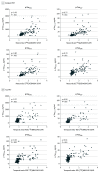Association of Phosphorylated Tau Biomarkers With Amyloid Positron Emission Tomography vs Tau Positron Emission Tomography
- PMID: 36508198
- PMCID: PMC9856704
- DOI: 10.1001/jamaneurol.2022.4485
Association of Phosphorylated Tau Biomarkers With Amyloid Positron Emission Tomography vs Tau Positron Emission Tomography
Abstract
Importance: The recent proliferation of phosphorylated tau (p-tau) biomarkers has raised questions about their preferential association with the hallmark pathologies of Alzheimer disease (AD): amyloid-β plaques and tau neurofibrillary tangles.
Objective: To determine whether cerebrospinal fluid (CSF) and plasma p-tau biomarkers preferentially reflect cerebral β-amyloidosis or neurofibrillary tangle aggregation measured with positron emission tomography (PET).
Design, setting, and participants: This was a cross-sectional study of 2 observational cohorts: the Translational Biomarkers in Aging and Dementia (TRIAD) study, with data collected between October 2017 and August 2021, and the Alzheimer's Disease Neuroimaging Initiative (ADNI), with data collected between September 2015 and November 2019. TRIAD was a single-center study, and ADNI was a multicenter study. Two independent subsamples were derived from TRIAD. The first TRIAD subsample comprised individuals assessed with CSF p-tau (p-tau181, p-tau217, p-tau231, p-tau235), [18F]AZD4694 amyloid PET, and [18F]MK6240 tau PET. The second TRIAD subsample included individuals assessed with plasma p-tau (p-tau181, p-tau217, p-tau231), [18F]AZD4694 amyloid PET, and [18F]MK6240 tau PET. An independent cohort from ADNI comprised individuals assessed with CSF p-tau181, [18F]florbetapir PET, and [18F]flortaucipir PET. Participants were included based on the availability of p-tau and PET biomarker assessments collected within 9 months of each other. Exclusion criteria were a history of head trauma or magnetic resonance imaging/PET safety contraindications. No participants who met eligibility criteria were excluded.
Exposures: Amyloid PET, tau PET, and CSF and plasma assessments of p-tau measured with single molecule array (Simoa) assay or enzyme-linked immunosorbent assay.
Main outcomes and measures: Associations between p-tau biomarkers with amyloid PET and tau PET.
Results: A total of 609 participants (mean [SD] age, 66.9 [13.6] years; 347 female [57%]; 262 male [43%]) were included in the study. For all 4 phosphorylation sites assessed in CSF, p-tau was significantly more closely associated with amyloid-PET values than tau-PET values (p-tau181 difference, 13%; 95% CI, 3%-22%; P = .006; p-tau217 difference, 11%; 95% CI, 3%-20%; P = .003; p-tau231 difference, 15%; 95% CI, 5%-22%; P < .001; p-tau235 difference, 9%; 95% CI, 1%-19%; P = .02) . These results were replicated with plasma p-tau181 (difference, 11%; 95% CI, 1%-22%; P = .02), p-tau217 (difference, 9%; 95% CI, 1%-19%; P = .02), p-tau231 (difference, 13%; 95% CI, 3%-24%; P = .009), and CSF p-tau181 (difference, 9%; 95% CI, 1%-21%; P = .02) in independent cohorts.
Conclusions and relevance: Results of this cross-sectional study of 2 observational cohorts suggest that the p-tau abnormality as an early event in AD pathogenesis was associated with amyloid-β accumulation and highlights the need for careful interpretation of p-tau biomarkers in the context of the amyloid/tau/neurodegeneration, or A/T/(N), framework.
Conflict of interest statement
Figures




References
-
- Montine TJ, Phelps CH, Beach TG, et al. ; National Institute on Aging; Alzheimer’s Association . National Institute on Aging-Alzheimer’s Association guidelines for the neuropathologic assessment of Alzheimer’s disease: a practical approach. Acta Neuropathol. 2012;123(1):1-11. doi: 10.1007/s00401-011-0910-3 - DOI - PMC - PubMed
Publication types
MeSH terms
Substances
Grants and funding
LinkOut - more resources
Full Text Sources
Medical
Miscellaneous

